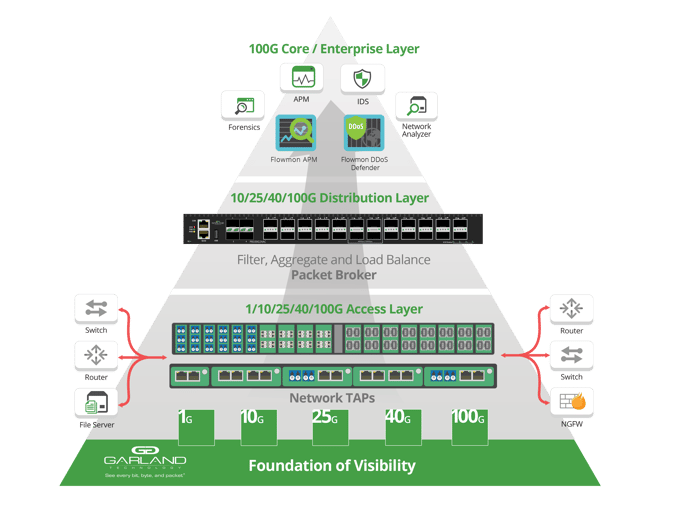Garland Technology and Flowmon Networks Help Businesses Ensure Availability in 100G Networks
June 27, 2017

 June 27, 2017: Buffalo, NY -After a year of successful cooperation, Flowmon Networks, a vendor of advanced network monitoring and security solutions, and Garland Technology, the leading manufacturer of network test access points (TAPs), announced today a joint solution addressing challenges of monitoring and security of high-speed data center networks.
June 27, 2017: Buffalo, NY -After a year of successful cooperation, Flowmon Networks, a vendor of advanced network monitoring and security solutions, and Garland Technology, the leading manufacturer of network test access points (TAPs), announced today a joint solution addressing challenges of monitoring and security of high-speed data center networks.
Flowmon is a long-standing pioneer in delivering monitoring and security tools for high-speed networks. It has formed a technology alliance with Garland Technology in June 2016. “Flowmon’s partnership with Garland reflects our shared, long-term commitment to enhancing network management and helping businesses to ensure high availability of their applications and services,” says Jiri Tobola, VP of Sales and Alliances at Flowmon Networks.
Thanks to the close cooperation, both parties have introduced a joint end-to-end solution for the management and security of high-speed, 100G networks. “We really appreciate Garland's focus and deep expertise in tapping and packet broker technologies for 100G environment. 10G technology can’t meet the future bandwidth demand, thus, 100G networks are the next step,” adds Jiri Tobola.
Garland ensures feeding the Flowmon solution with constant, accurate data for analysis from all across the network. Thanks to that, Flowmon’s engine is able to execute real-time analytics in order to help administrators to deal with operational and security issues.
Garland has recently introduced a new product line of 100G purpose built packet brokers and 10G/40G/100G passive fiber TAPs to create an end-to-end visibility solution. “Our investment in 100G technologies – for both the access and distribution layers is customer driven. As networks are transitioning from 10G to 40G and 100G speeds, monitoring technologies such as Flowmon’s NetFlow/IPFIX need high performance, reliable solutions that are scalable to the changing network speeds,” says Chris Bihary, CEO/Co-Founder at Garland Technology.
Creating a foundation of visibility at the physical layer is Garland Technology’s core focus. From their 1G/10G/40G/100G network TAPs that ensure 100% packet capture for monitoring, performance and analysis tools at the access layer’s as well as filtering, aggregating and load balancing the packets to the distribution and core network layers with Garland’s new efficient and cost effective purpose built packet brokers.

About Flowmon Networks
Flowmon Networks empowers businesses to manage and secure their network infrastructure confidently. Through our high performance monitoring technology and lean-forward behavior analytics, IT pros worldwide benefit from absolute network traffic visibility to enhance network & application performance and deal with modern cyber threats. Recognized by Gartner, we are leading the way of NetFlow/IPFIX network monitoring that is high performing, scalable and easy to use. Enterprises, internet service providers, government entities or even small and midsize companies rely on our solutions to take control over their networks, keep order and overcome uncertainty.
About Garland Technology
Garland Technology guarantees precise data monitoring capabilities with a full line of network test access points (TAPs) including: network TAPs that support breakout, aggregation, regeneration and bypass modes; packet brokering, load balancing and filtering products; all available in portable, 1U or 2U chassis systems. Garland network TAPs support all networks, including copper wire in 10/100M, 10/100/1000M and fiber in 1G, 10G, 40G, 100G.
Garland‘s network access products provide the best solution for any monitoring or security appliance - allowing you to see every bit, byte and packet®. For more information, visit http://www.garlandtechnology.com. Follow on Twitter @GarlandTech.
